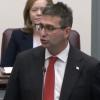Fireworks, Sons of Liberty, Big Brother and dry, windy June
As twilight eased into night on July Fourth, lots of people waited, wondering whether there would be more flashing lights than the reds and blues atop the Lewes Police patrol car at the end of Savannah Road by Lewes Beach.
Jim sat in a chair at a party nearby, tossing a bean bag for his granddaughter, musing about history and 1776. Flaming tiki torches over his shoulder brought to mind Boston and Tea Party and revolutionaries marching toward the waterfront.
Jim motioned toward the beach. “The Sons of Liberty are out there now getting ready to set off some fireworks. This is how it all gets started. It’s American. Tell an American he can’t do something and that’s exactly what he’s going to want to do.”
Within a few minutes, booming volleys and bursts in the sky confirmed Jim’s prediction.
But the volleys and bursts were greatly diminished from previous years.
For the past few weeks, Lewes Police pleaded with the public not to break the law by setting off fireworks.
Chief Spell had threatened confiscation, and forces and signs were added to remind people of the law. In the end it all worked, for the most part.
Mayor Ted Becker said he was accosted in the Doo-Dah Parade by just one person who gave him an earful about the fireworks prohibition. And he announced during the Children’s Games on Second Street that in 2018 there would be an officially sanctioned, and legal, fireworks display on Fourth of July in Lewes sponsored by the city, businesses and individuals who would contribute to the effort.
A TALL METAL FLAGPOLE with a camera, not a flag, now dominates the busiest intersection in Lewes. Last week a DelDOT crew erected the industrial-grade pole on the southwest corner where Savannah Road and Front Street meet at the foot of the drawbridge.
Becker said he knew the pole was coming but he had no idea it was going to be that tall. The camera is similar to one used at many intersections around the state to monitor traffic flow. “Maybe they’re trying to monitor New Jersey.”
He later said he had spoken with DelDOT officials who said they would take another look at the height of the pole. “I was told the one there now is 75 feet. That’s really tall, especially considering the building height limit in downtown Lewes is something like 42 feet. One of the reasons given for the height was to be able to monitor flooding conditions around the canal,” said Becker.
DelDOT Director of Community Relations Charles McLeod added to the conversation: “This camera, when it becomes operational, will be the latest addition to our statewide network of 160 publicly available live traffic condition cameras,” wrote McLeod.
“The location of the camera was chosen to allow real-time monitoring of the drawbridge and Savannah Road, which we have not previously had. The 75-foot height was chosen so that the length of Savannah Road to the bay is visible allowing us to monitor conditions during storms, and whether Savannah Road is being impacted, and we coordinated this project with input and approval from city officials. The total cost to purchase the equipment and install is roughly $100K and is part of the traffic signal rebuild project at this intersection.”
Several years ago, the Lewes Board of Public Works stirred the public’s ire when it advocated for erection of several towering power poles across the heart of downtown Lewes.
The plan was eventually scrapped and the principal advocate lost his seat in the next election.
In a town that prides itself on deep history, the new, intrusive camera installation with its high-tech implications stands as much as a giant question mark as it does a formidable pole.
Without a question, it’s out of scale.
JUNE FELT UNUSUALLY windy to me. Definitely more so than last year. Valerie Meola of the National Weather Service in Mt. Holly, New Jersey pointed me to statistics to take a look. “We don’t keep an eye on wind too much but there are some daily figures there,” she told me.
It turns out that the average wind speed in June in Sussex County, recorded at a Georgetown station, was 7.2 miles per hour compared to 6.6 mph in June 2016. Based on the past several years though, that’s not unusual. In 2013, the average speed for the month was 6.4, in 2014 it was 8.6 and in 2015 it was 7.6.
I’m still working on determining whether there was much difference in winds recorded along the coast.
On the other hand, June was definitely drier than normal. Accuweather Meteorologist Brian Edwards said June’s precipitation in Sussex of 1.8 inches was 47 percent below the normal average of 3.6 inches.
So far in 2017, total rainfall in Sussex County - also measured in Georgetown - is 18 inches compared to a normal average of 22.4 inches.
Of course now we’re in the thunderstorm time of the year. Nature doesn’t pay much attention to fireworks laws.





















































